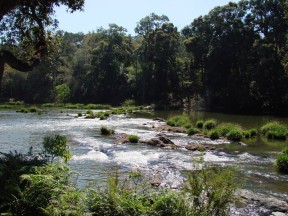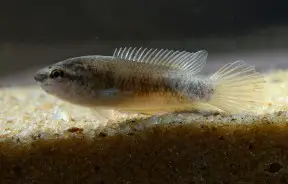Pseudosphromenus cupanus
Spiketail Paradisefish
SynonymsTop ↑
Polyacanthus cupanus Cuvier, 1831; Macropodus cupanus (Cuvier, 1831); Psedosphronemus cupanus (Cuvier, 1831)
Etymology
Pseudosphromenus: from the Ancient Greek ψευδής (pseudes), meaning ‘false, lying, untrue’, and a misspelling of the generic name Osphronemus.
cupanus: named for the Arian Coupang River, India, type locality of the species.
Classification
Order: Perciformes Family: Osphronemidae
Distribution
Often reported to range throughout much of southern Asia, incuding Bangladesh, Indonesia, Malaysia, Myanmar, and Pakistan, but in reality this species is restricted to southern India and Sri Lanka.
Type locality is ‘Arian-Coupang River, Puducherry, India’, which corresponds to the Sankaraparani River (also known as the Gingee or Varahanadi) in Tamil Nadu state, southern India.
Habitat
Apparently shows a preference for sluggish and still waters such as rice paddies, swamps and weedy ponds, tending to be most common in floodplains and other lowland areas.
It has also been collected from the margins of rivers and ditches with dense growths of submerged vegetation.
Maximum Standard Length
60 – 65 mm.
Aquarium SizeTop ↑
Minimum base dimensions of 60 ∗ 30 cm or equivalent are recommended.
Maintenance
Can be maintained in a fully-decorated aquarium although many breeders prefer not to use a substrate for ease of maintenance.
Driftwood roots and branches can be used and placed such a way that a few shady spots are formed, while half-coconut shells or upturned clay flower pots with entrance holes chipped in the rims represent ideal spawning sites (see ‘Reproduction’).
The addition of dried leaf litter further emphasises the natural feel and as well as offering additional cover brings with it development of microbe colonies which can provide a valuable early food source for fry.
This species prefers fairly dim lighting so the use of surface vegetation, floating or otherwise, is also useful.
As it naturally inhabits sluggish waters filtration should not be too strong, with an air-powered sponge unit adequate.
Water Conditions
Temperature: 20 – 28 °C
pH: 6.0 – 7.5
Hardness: 36 – 447 ppm
Diet
Likely to prey on insect larvae and suchlike in nature, and should be offered small live or frozen Daphnia, Artemia, white worm, grindal worm, etc., in captivity.
Dried foods may be examined and even pecked at but are not consumed in sufficient quantities to bring about optimal condition.
Small insects such as crickets or Drosophila fruit flies are also suitable to use; it is best to fill the stomachs of these by feeding them fish flakes or some kind of vegetable matter before offering them to the fish.
Behaviour and CompatibilityTop ↑
This species is peaceful but does not make an ideal community fish due to its small size and rather timid nature.
Some small cyprinids and loaches that inhabit similar environments in nature are compatible but similar-shaped fishes are best-omitted.
It can be maintained in a pair or group and will display some interesting behavioural interactions under the latter circumstances.
Sexual Dimorphism
Adult males develop extended dorsal, anal and caudal fins. Nuptial males display more intense fin colouration and a pale body, while females darken in colour.
This species can also be sexed by placing a strong light behind the fish; in females the ovary is thus visible as a posterior, laterally-orientated extension of the internal organs which is lacking in males.
Reproduction
Secretive bubble nester, with males preferring to construct nests under an overhang or in a cavity if available, though if not surface vegetation, leaves or roots may be chosen.
In the aquarium half-coconut shells, upturned flowerpots, clay pipes, or pieces of floating cork bark provide ideal artificial spawning sites. Males normally construct a compact bubble nest with both male and female attempt to attach the eggs to the ceiling of the site after they are released.
Eggs and milt are released in small batches during a series of embraces in which the male wraps its body around that of the female. Post-spawning the female is normally ejected and the male solely responsible for guarding and tending the eggs.
Incubation is approximately 24-48 hours with the fry free-swimming after 2-3 additional days after which they are able to accept Artemia nauplii, microworm, etc.
Once the fry are swimming freely they may be consumed by other fish in the aquarium, including their mother, so are best separated and grown on elsewhere.
NotesTop ↑
This species is most easily told apart from its only congener P. dayi by lacking (vs. possessing) two dark, irregular lateral stripes on the head and body, and a shorter caudal-fin in males.
The results of phylogenetic analyses by Rüber et al. (2006) suggest that Pseudosphromenus is most closely-related to Malpulutta in an evolutionary sense. Both are sometimes included in the putative subfamily Macropodusinae alongside the genera Macropodus, Parosphromenus, Betta and Trichopsis.
Like others in the suborder Anabantoidei this species possesses an accessory breathing organ known as the labyrinth, which permits the fish to breathe atmospheric air to a certain extent. Comprising paired suprabranchial organs formed via expansion of the epibranchial (upper) section of the first gill arch and housed in a chamber above the gills, it contains many highly-vascularised, folded flaps of skin which function as a large respiratory surface. Its structure varies in complexity between species, tending to be more developed in those inhabiting harsher environments. While some labyrinth fishes can be observed taking regular gulps of air from the surface others, including Pseudosphromenus spp., do so less often.
References
- Cuvier, G. and A. Valenciennes, 1831 - F. G. Levrault, Paris. v. 7: i-xxix + 1-531
Histoire naturelle des poissons. Tome septième. Livre septième. Des Squamipennes. Livre huitième. Des poissons à pharyngiens labyrinthiformes. - Kullander, S. O., M. M. Rahman, M. Norén and A. R. Mollah , 2015 - Zootaxa 3990(4): 575-582
Why is Pseudosphromenus cupanus (Teleostei: Osphronemidae) reported from Bangladesh, Indonesia, Malaysia, Myanmar, and Pakistan? - Linke, H., 1992 - Tetra Press: 176 pp.
Labyrinth Fish: The Bubble Nest Builders. - Rüber, L., R. Britz, R., and R. Zardoya, 2006 - Systematic Biology 55(3): 374-397
Molecular phylogenetics and evolutionary diversification of labyrinth fishes (Perciformes: Anabantoidei).









December 17th, 2014 at 7:00 pm
Stumbled across a trio of small, anonymous grey individuals hiding amongst the usual pet shop regulars. A quick q&a got the Paradise name and SF provided the rest. Being far less troublesome, and notably smaller than their cousins they were soon heading to my 60*30cm, 70l tank with Corydoras Agassizii as the sole longterm tankmates. They settled in quickly taking crushed flake with relish, combined with occasional frozen food.
A few weeks later and they had developed enough to lead to a tentative sexing of 1m+2f, confined a few weeks later still when the male turned decidedly pink and built his nest under a coconut shell half (water parameter tds 160, ph7.0, 24c).
The first two attempts were unsuccessful with eggs going white, however the third soon led to a cloud of small fry.
Sadly I came home with the intention of syphoning off a few fry now they were a few days old only to find no evidence of them, and the male still visiting but less guarding of the shell. I’m sure it won’t be too long before there more action.
….
Compared to the larger Black or Striped Paradise fish species these may seem initially rather boring, however don’t let it put you off. Not the most colourful in normal times but breeding brings on dark female and pale male bodies. Mine do chase each other on occasion, although as far as territorial displays go the male only guards the general vicinity of the nest site chasing the females away and generally ignoring all but the closest of cory advances.
Recommended to those seeking a smaller more intricately beautiful and community friendly fish and who is willing to look beyond the brighter and sometimes garish colours of most
February 10th, 2015 at 10:22 pm
My Spiketails are now breeding every 2 weeks or so. Once the fry have scattered there is a 2 or 3 day break and the courting starts once more, usually with the same female but I have noticed on a couple of occasions both females and the male squeezed in under the cramped dome of the cocunut shard.
Although the male guards the eggs and fry with aplomb some do escape before the male finally leaves them to their fate. Any that do escape swim quickly upwards to the surface amongst floating plants where the females pick them off. So far after 7 or more attempts I still only have 2 survivors who now look like proper miniature paradisefish. I suspect if the adults were removed or the tank split then a rather large success rate could be achieved with ease. In the meantime I am happy with increasingly thick islands of riccia to hide the babies and giving them a fighting chance.